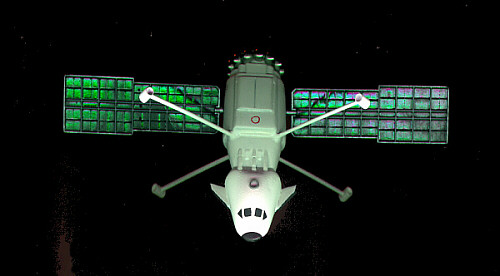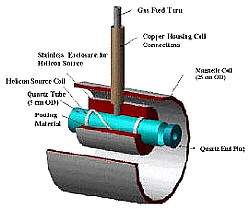Sailing On The Solar Winds
"I thought that they were angels, but to my surprise
They climbed aboard their starship and headed for the skies
Singing come sail away, come sail away
Come sail away with me
Come sail away, come sail away
Come sail away with me." - Dennis DeYoung
 |
Solar sails use the pressure of sunlight in much the same way that a yacht uses the wind. Instead of yards of canvas, a traditional solar sail utilizes aluminum foil only 1/100,000 mm thick and many kilometers across. Despite a very large sail area, the pressure of sunlight is so slight that the resulting acceleration - although constant - is tiny (only 0.0001g for a 5,000 kg spacecraft). However sunlight is free, so if you're not in a big hurry substantial velocities can be built up over time.
Plasma sails offer an attractive alternative to conventional solar sails. Instead of large, fragile, unwieldy foil sails, a plasma sail uses the solar wind to push a small imitation of the Earth's magnetosphere to accelerate the spacecraft. As an added bonus, just as Earth's magnetic field shields our planet from dangerous solar eruptions and radiation storms, a magnetic plasma sail protects the occupants of a spacecraft.
 "Mini-Magnetosphere Plasma Propulsion" (M2P2) was developed by Dr.Robert Winglee of the University of Washington at the end of the 20th century. In an M2P2 spacecraft, a magnetic field of 0.1 Tesla (about 1000 times stronger than Earth's magnetic field) 15 to 20 kilometers across is generated by a conventional solenoid using electricity provided by solar cells. The M2P2 generators (see drawing at right) are mounted on long, retractable booms projecting outward from the spacecraft's hull. The space vessel pictured above, the USV Leda (view conceptual sketch), is a hybrid (mid-21st century) that utilizes four high-efficiency M2P2 generators for solar sailing and a conventional chemical (LH/LOX) rocket motor for brief, high-thrust maneuvers such as orbital breaking. The M2P2 taps a small amount of the rocket's propellant and ionizes it to create the plasma sail. The 85 foot long spacecraft can be steered by spinning the magnetic field, which results in the solar wind striking the field at different speeds and causes the vessel to change course on a tangent.
"Mini-Magnetosphere Plasma Propulsion" (M2P2) was developed by Dr.Robert Winglee of the University of Washington at the end of the 20th century. In an M2P2 spacecraft, a magnetic field of 0.1 Tesla (about 1000 times stronger than Earth's magnetic field) 15 to 20 kilometers across is generated by a conventional solenoid using electricity provided by solar cells. The M2P2 generators (see drawing at right) are mounted on long, retractable booms projecting outward from the spacecraft's hull. The space vessel pictured above, the USV Leda (view conceptual sketch), is a hybrid (mid-21st century) that utilizes four high-efficiency M2P2 generators for solar sailing and a conventional chemical (LH/LOX) rocket motor for brief, high-thrust maneuvers such as orbital breaking. The M2P2 taps a small amount of the rocket's propellant and ionizes it to create the plasma sail. The 85 foot long spacecraft can be steered by spinning the magnetic field, which results in the solar wind striking the field at different speeds and causes the vessel to change course on a tangent.
Self-powering Plasma Sails: It may be possible to use the solar wind as a power source for a plasma sail spacecraft without the need for large solar panels. Stephen Goodfellow has suggested that by placing a cathode and anode on the North and South poles of a modified generator, the spacecraft's batteries could be continuously recharged by the solar wind. The magnetic lines of the spacecraft's spinning magnetic field would funnel charged particles toward the generator's poles in much the same way that the Earth's magnetosphere funnels charged particles. Goodfellow suggests that even after the spacecraft leaves the solar heliopause, its speed through interstellar space may be sufficient that trapped ions could continue to charge the batteries.
If you'd like to learn more about plasma sails, then visit "Dashing and Coasting to the Interstellar Finish Line". More information about solar sails may be found at the U3P Solar Sails Site and at Solar Sails Info.